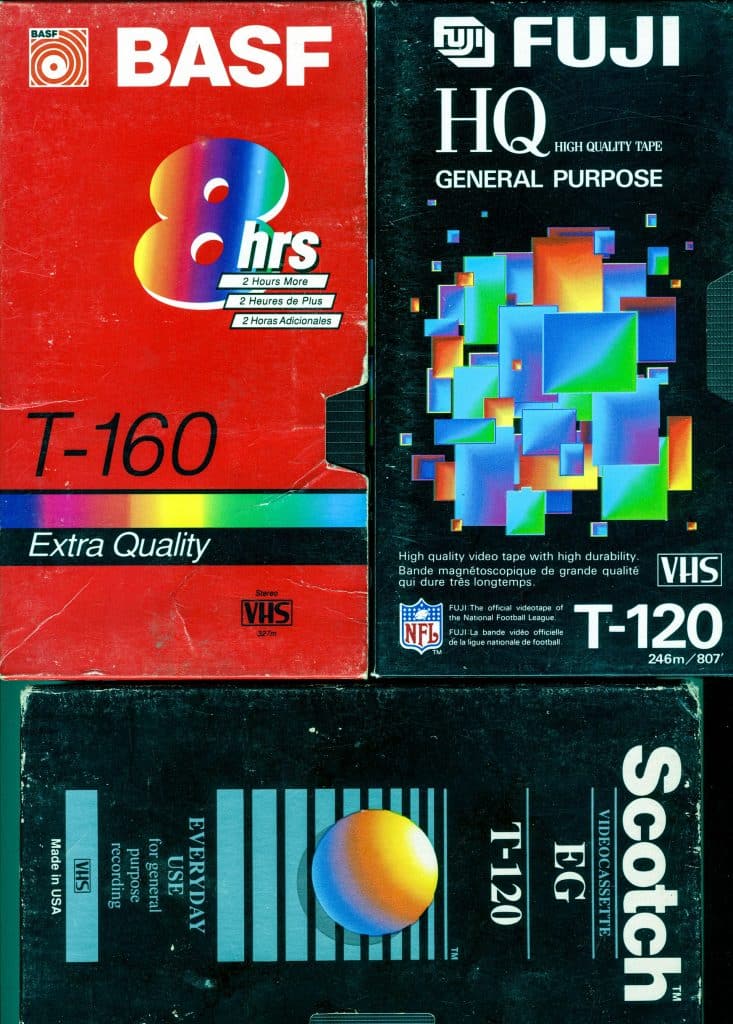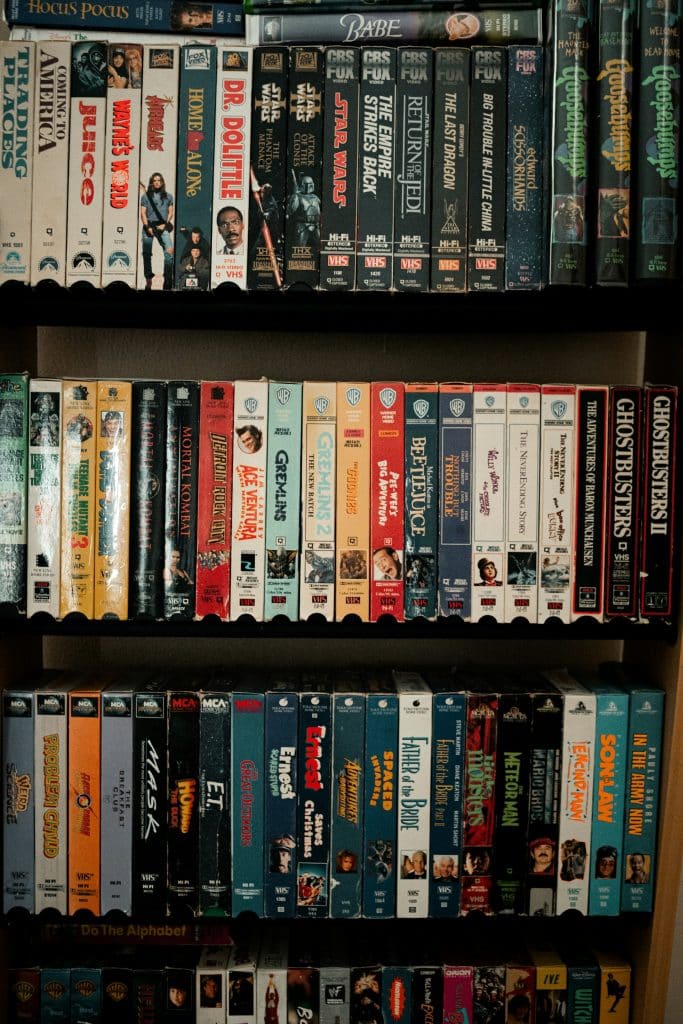The VHS, or Video Home System, holds a special place in the history of home entertainment. Introduced as a competitor to Betamax, the VHS format quickly gained popularity in the 1980s and became the dominant choice for recording and playing back videos.

Over the years, VHS technology evolved, improving video quality and playback capabilities. What started as a lower-quality format eventually transformed into a widely accessible and affordable option for consumers.
The introduction of the VHS format in 1976 marked a turning point in home entertainment. Suddenly, people had the power to bring movies and TV shows into the comfort of their own homes. The rental market boomed as video rental stores popped up, offering a wide selection of VHS tapes for customers to enjoy.
Key Takeaways:
- VHS revolutionized the entertainment industry with its introduction in the 1980s.
- The technology of VHS tapes evolved, improving video quality and playback capabilities.
- VHS became the dominant format for home video recording and playback.
- The introduction of VHS format brought movies and TV shows into people’s homes.
- The rental market boomed as video rental stores offered a wide selection of VHS tapes.
The VHS vs Betamax Battle
One of the most notable aspects of VHS history is the fierce battle between VHS and Betamax. Both formats emerged in the late 1970s, but VHS eventually emerged victorious due to several reasons.

VHS tapes quickly gained popularity among consumers because they offered longer recording times and were less expensive than Betamax tapes. This affordability and extended recording capability made VHS a more attractive choice for the average consumer looking to record television shows and movies at home.
The ability to record at home sparked a revolution in home entertainment, bringing the cinematic experience into people’s living rooms. VHS tapes became a staple in households across the United States, with families enjoying the flexibility and convenience of watching their favorite programs on their own schedule.
VHS tapes also benefited from widespread industry support, with major movie studios and television networks primarily releasing content on VHS format. This availability of VHS tapes further contributed to their growing popularity and adoption by consumers.
| Comparison | VHS | Betamax |
|---|---|---|
| Recording Time | Longer recording times | Shorter recording times |
| Cost | Less expensive | Relatively more expensive |
| Industry Support | Widespread support from movie studios and television networks | Less industry support |
The VHS vs Betamax battle was a turning point in the history of home video recording. With its affordability, extended recording capabilities, and widespread adoption, VHS emerged as the dominant format, ultimately shaping the way we consume and experience entertainment at home.
The Impact of VHS on the Entertainment Industry
The introduction of VHS had a monumental impact on the entertainment industry. It transformed the way people consumed media and brought movies and television shows into the comfort of their homes. The rental market exploded as video rental stores popped up all over the country, offering a wide selection of VHS tapes for customers to enjoy. However, with the rise of DVD and digital streaming, VHS eventually declined in popularity and production ceased in 2008.
VHS revolutionized the entertainment industry by providing consumers with unprecedented access to movies and television shows at home. This convenience and accessibility transformed the way people consumed media. They no longer had to rely on scheduled programming or expensive cinema visits; instead, they could enjoy their favorite films in the comfort of their living rooms.
“VHS tapes allowed people to create their own libraries of movies and TV shows, building personalized collections that catered to their unique tastes.”
In addition to changing consumer behavior, the introduction of VHS also had a significant impact on the business side of the entertainment industry. Video rental stores sprouted up across the country, offering a vast selection of VHS tapes for customers to choose from. This innovative distribution model gave rise to a booming rental market, allowing viewers to enjoy a wide range of movies without the need for purchase.
“Video rental stores became a hub for movie enthusiasts, providing a social experience where people could browse, discover, and share their favorite films with friends and family.”
However, as technology advanced and new formats emerged, such as DVD and digital streaming, VHS started to lose its appeal. The convenience, higher video quality, and compact size offered by these new formats gradually overshadowed VHS. As a result, VHS sales declined, and production eventually ceased in 2008.
VHS Collectors and the Nostalgia Factor
Despite the decline of VHS, there is still a dedicated community of VHS collectors who appreciate the nostalgia and unique charm of the format. These collectors seek out rare and obscure VHS tapes, creating a market for vintage VHS tapes. The nostalgia factor plays a significant role in the continued interest in VHS, with many collectors reminiscing about their childhood memories of watching movies on VHS.

Embracing the Nostalgia
VHS collectors are driven by a deep sense of nostalgia, drawn to the tangible and tactile nature of VHS tapes. The act of inserting a cassette into a VCR, the distinctive hum of the tape rewinding, and the anticipation of watching a movie from start to finish evoke a rush of memories from a bygone era. For many, collecting VHS tapes is not just about the movies themselves, but rather the experience and emotions tied to the format.
The Thrill of the Hunt
For VHS collectors, hunting down rare and elusive tapes is a thrilling adventure. They scour garage sales, flea markets, and online marketplaces in search of hidden gems that may have been forgotten or discarded. The thrill comes from the discovery of a tape they’ve been searching for or stumbling upon a hidden treasure they never knew existed. It’s the joy of unearthing a piece of history and adding it to their cherished collection.
The Rarity Quotient
One of the appeals of VHS collecting is the rarity of certain tapes. Limited releases, discontinued films, and obscure titles are highly sought after by collectors who value the exclusivity and uniqueness of their collections. The scarcity of certain VHS tapes adds a sense of excitement and prestige to the hunt, as collectors compete to acquire these coveted pieces of cinematic history.
A Community United by Passion
VHS collectors form a close-knit community, united by their shared love for the format. Online forums, social media groups, and VHS conventions serve as gathering places for collectors to connect, share their finds, and engage in lively discussions about all things VHS. The community aspect adds an extra layer of enjoyment to the hobby, allowing collectors to connect with like-minded individuals who understand their passion.
Image:
| VHS Collectors and Nostalgia | Reasons for Collecting |
|---|---|
| Embracing nostalgia | Reliving childhood memories |
| The thrill of the hunt | Searching for rare and obscure tapes |
| The rarity quotient | Collecting limited and discontinued releases |
| A community united by passion | Connecting with fellow collectors |
Evolution of VHS Technology
Throughout its history, VHS technology has undergone significant advancements and improvements. From its humble beginnings with lower video quality and limited recording times, VHS tapes evolved to offer higher-quality recordings and extended playback capabilities.
With the constant pursuit of enhancing user experience, VHS technology embraced various innovations to meet the demands of consumers. One notable development was the introduction of extended play (EP) and super extended play (SEP) modes. These modes allowed for even longer recording times, giving users the freedom to capture more of their favorite shows and movies on a single tape.

Additionally, VHS technology saw improvements in video quality as advancements were made in tape formulation and cassette design. Better signal processing and noise reduction techniques contributed to enhanced image and audio reproduction, offering viewers a more immersive and enjoyable home entertainment experience.
“The evolution of VHS technology brought about significant improvements in recording capabilities and video quality. With longer recording times and enhanced playback features, VHS became a versatile and reliable format for capturing and enjoying content at home.”
Furthermore, VHS technology continued to adapt to changing consumer needs by incorporating features such as on-screen displays, index search functions, and automatic tracking adjustment. These advancements made navigating and accessing specific content on VHS tapes more convenient and user-friendly.
While the rise of digital formats eventually led to the decline of VHS, the continuous evolution of VHS technology played a crucial role in its prolonged popularity. The constant advancements in tape quality, recording capabilities, and playback features ensured that VHS remained a competitive and trusted format for home entertainment for several decades.
The Rise of VHS Format and Popularity
The introduction of VHS format in 1976 marked a turning point in home entertainment. This new video cassette format quickly gained popularity among consumers due to its compatibility with multiple playback devices. VHS tapes were widely available, creating a massive demand among movie enthusiasts and casual viewers alike.
The proliferation of video rental stores added to the popularity of VHS tapes. People flocked to these stores to get their hands on the latest movies and TV shows, fueling the rental market boom. The accessibility and affordability of VHS tapes played a significant role in their widespread adoption by households across the country.
“VHS gave consumers the power to bring movies and TV shows into their own hoes, changing the way we enjoyed entertainment forever.”
VHS tapes offered a convenient way to watch favorite movies and record television shows at home. With the advent of VHS format, people no longer had to rely on theaters or television schedules to enjoy their favorite content. They could create their own personalized video libraries and enjoy entertainment at their own pace.
The rise of VHS format and the popularity of VHS tapes laid the foundation for a new era in home entertainment, shaping the way we consume media.
VHS in the Digital Age
With the rise of DVD and digital streaming, VHS faced a decline in popularity. The convenience and higher video quality offered by these new formats led to a shift away from VHS. Production of VHS tapes ceased in 2008, marking the end of an era in home entertainment. However, VHS still holds a special place in the hearts of many, and its impact on the entertainment industry cannot be understated.
In the digital age, advancements in technology have completely transformed the way we consume media. Streaming platforms like Netflix, Hulu, and Amazon Prime offer instant access to a vast library of movies and TV shows, eliminating the need for physical copies. The convenience of streaming services, combined with the ability to watch content on multiple devices, has made them the preferred choice for many viewers.
DVDs also played a significant role in the decline of VHS. DVDs offered superior video and audio quality, interactive menus, and special features that were not possible with VHS tapes. They became the new standard for home entertainment, quickly replacing VHS as the go-to format for movies and TV shows.
While VHS may have faded into obscurity, it remains an important part of history. Its legacy is evident in the cultural impact it had on society and the fond memories it continues to evoke in those who grew up during the VHS era.
The rise of DVD and digital streaming marked a new chapter in home entertainment, leaving VHS behind. However, the significance of VHS cannot be overstated. It revolutionized the way we watched movies and brought the magic of cinema into our living rooms.
Despite its decline, there are still those who appreciate the unique charm of VHS. VHS collectors avidly seek out rare tapes and build impressive collections. The nostalgia associated with VHS taps into a sense of sentimentality, transporting individuals back to a simpler time of movie nights and video rental stores.
While VHS may never regain its former glory, its influence on the entertainment industry will always be remembered. It paved the way for future advancements and left an indelible mark on the history of home entertainment.
VHS in Popular Culture
VHS has become an iconic symbol of popular culture, leaving a lasting impression on movies, TV shows, and music. The distinctive design of VHS tapes and the act of rewinding have become nostalgic reminders of a bygone era, invoking a sense of vhs nostalgia among those who grew up during the 80s and 90s.
“VHS tapes hold a special place in my heart. They embody a time when we would gather around the TV, anxiously waiting for our favorite movies to start. The crackling sound as the tape played and the need to rewind after each viewing added an element of anticipation and excitement that digital formats simply can’t replicate.” – Shawn
In movies and TV shows, VHS tapes are often featured as plot devices or visual cues, showcasing their cultural significance. Characters might be seen browsing through stacks of VHS tapes at a video rental store, inserting a tape into a VCR, or anxiously waiting for a rewind to finish.
Music videos and album covers frequently pay homage to the VHS era, incorporating retro VHS effects and aesthetics. Artists embrace the grainy visuals, tracking lines, and distorted colors to evoke an atmosphere of nostalgia and celebrate the charm of VHS.
VHS References in Popular Culture
Here are some notable examples of VHS references in popular culture:
| Movie/TV Show | VHS Reference |
|---|---|
| Stranger Things | The show prominently features VHS tapes, with references to popular movies from the 80s. |
| Guardians of the Galaxy | Star-Lord’s mixtape, “Awesome Mix Vol. 1,” is on a cassette tape, reminiscent of VHS culture. |
| Ready Player One | The movie showcases countless pop culture references, including VHS tapes and classic movies. |
VHS has embedded itself in popular culture, serving as a time capsule that transports us back to a simpler era of physical media and shared movie-watching experiences. Its legacy continues to resonate with both older generations who grew up with VHS and younger audiences who appreciate its retro charm.
Conclusion
The history of the VHS is a captivating journey that began with its introduction as a competitor to Betamax and ended with its decline in popularity due to advancements in technology. Despite its eventual decline, the impact and nostalgic charm of VHS continue to enchant enthusiasts and collectors.
VHS revolutionized the home entertainment industry, offering consumers the ability to record and watch their favorite movies and TV shows at their convenience. It became the dominant format, dominating the rental market and becoming a staple in households across the United States.
However, with the advent of DVD and digital streaming, VHS faced a decline. The convenience, higher video quality, and the introduction of new formats led to a shift away from VHS. Production of VHS tapes ceased in 2008, marking the end of an era.
Despite its decline, VHS holds a special place in the hearts of many, serving as a nostalgic symbol of a bygone era. The legacy of VHS will always be remembered as a significant chapter in the history of home entertainment, reminding us of the joy and excitement of watching movies on VHS tapes.
FAQ
What is the history of VHS?
The VHS, or Video Home System, was introduced as a competing format to Betamax in the late 1970s. It quickly gained popularity and became the dominant format for home video recording and playback.
How did VHS surpass Betamax in popularity?
VHS tapes became more popular among consumers due to their longer recording times and lower cost compared to Betamax. This, along with the ability to record television shows and movies at home, sparked a revolution in home entertainment.
What impact did VHS have on the entertainment industry?
The introduction of VHS transformed the way people consumed media and brought movies and television shows into the comfort of their homes. It led to the rise of video rental stores and created a booming rental market.
Why did VHS decline in popularity?
With the rise of DVD and digital streaming, VHS faced a decline in popularity due to the convenience and higher video quality offered by these new formats. Production of VHS tapes ceased in 2008.
Are there still VHS collectors?
Yes, there is still a dedicated community of VHS collectors who appreciate the nostalgia and unique charm of the format. They seek out rare and obscure VHS tapes, creating a market for vintage VHS tapes.
How did VHS technology evolve over the years?
VHS technology improved over the years, with advancements in video quality and playback capabilities. Physical changes, such as the introduction of extended play (EP) and super extended play (SEP) modes, allowed for even longer recording times.
How did VHS format become popular?
The VHS format became popular among consumers due to its compatibility with multiple playback devices. VHS tapes were widely available, and the rental market boomed as people flocked to video rental stores to enjoy the latest movies and TV shows.
How did VHS impact popular culture?
VHS has made a lasting impact on popular culture, with numerous references and tributes in movies, TV shows, and music. The iconic VHS tape design and the act of rewinding tapes have become nostalgic symbols of a bygone era.
What is the conclusion of the VHS era?
The convenience and higher video quality offered by DVD and digital streaming led to a decline in VHS popularity. Production of VHS tapes ceased in 2008, marking the end of an era in home entertainment.

